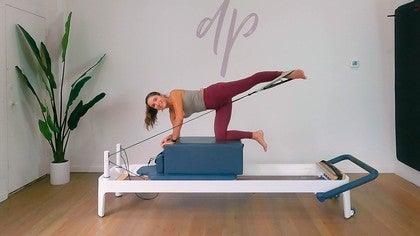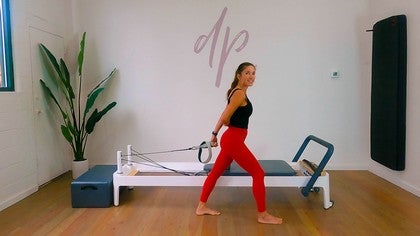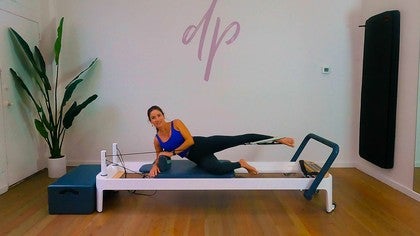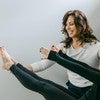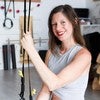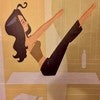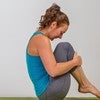Description
About This Video
Transcript
Read Full Transcript
Hi, I'm Delia Buckmaster. And welcome back to my studio in Whitefish, Montana, where I'll be bringing you a series on the reformer called Level Up. Today, we're gonna be doing lower body. Now, because it is a Pilates class, of course, we're gonna be touching on the torso and also a little bit of upper body, but mainly focusing on the strength of the lower extremities. So we're gonna start first by facing side.
You have a reformer to the left of you. I do, anyway. I'm gonna reach my arms up for a nice breath. Inhale. And then exhale to bring my arms down. What I'm trying to do is just to get my breath to be nice and fluid so that it could work from me for the entire class.
Inhale up as the shoulders rise. And exhale as they come down. I'm gonna give myself one more. As I reach, I'm gonna give myself a big stretch, maybe sending my hips slightly forward. And then bringing my arms down.
From here, I'll roll down. Nice standing roll down, reaching my arms towards the floor, and being very conscious to soften my knees. From here, I'm gonna roll myself all the way back up one vertebra at a time, and reaching my arms up to the sky. Now, the reason I'm softening my knees is because I have a tight or I have tight hamstrings. So if I don't soften my knees, then it would take a little bit too much pressure into my lower back.
And being that we're working in the lower extremities mainly today, I wanna make sure that I'm really aware of that part of my body. So one more as I roll myself all the way down. I'm going to stretch and just pause here for a moment. Maybe push my hips back just slightly. But again, with soft knees, I'm feeling the stretch mainly at the back of my legs here and not at the lumbar spine and not so much at the back of my knee.
So really high on the hamstrings where they attach to the sitz bones. My arms are reaching for the floor and I'm gonna let that tension go. After taking a couple of breaths here, I'm gonna roll up. And then I'm just gonna do some basic squats and parallels. So I'll bend my knees, dropping my bottom back, and reaching my arms forward for counterbalance.
So inhale, and then exhale. Feet are parallel. All three points of my feet are pressing into the floor. So two at the front of my feet, and then my heel at the back. And I'm paying attention here to what my legs are doing, where my knees are going.
Am I collapsing in? Am I collapsing out? Am I feeling this in my glutes? Make sure to maintain a nice neutral pelvis and that'll help to engage the glute muscle. And, of course, here is where you can bring some awareness to your pelvic floor. We'll do four more. Inhale, exhale up.
Three and lift. And again, exaggerating a little bit of a chest opener. And one more. And then all the way back up. One last reach for the sky, and then arms come right back down to the hips. Walking forward to the reformer, I'm gonna go into some basic lunges.
My left foot will come back to the block, knee rests on the reformer, right foot is in line with the spring load. And I right now have one full spring or, on this balance body, Allegro 2, it is a red spring. From here, I'll press the carriage back, bending the forward knee, and then returning the carriage. I'm going into this active lunch and focusing on my left hip flexor stretching and activating my glute muscle in that lunge. So the right leg that's on the floor is the leg that's moving the carriage, basically.
And then my hip is following through. My left arm is in line with the shoulder. And the reason it's in line with the shoulder is it'll keep your body nice and straight and square, pressing back and forth. On the next one, I'm just gonna hold back for just a moment, reaching my right arm towards the ceiling, and then giving myself a nice little rotation, opening the right shoulder. And then I'll bring that arm back, and then return the carriage.
So from here, I'm going to lift that left knee now off of the carriage and try a few with the leg extended. So I'm gonna extend that leg back, and then return forward. So while I'm doing this, now I've gotta put a little bit more weight on that standing leg and reach. Now, as I'm doing these, I'm gonna release that right arm and come into a nice rotation. Inhale to open. Exhale to return.
And as I reach, I wanna follow my hand with my eyes, as my eyes will lead my spine. One more time, and then forward. From here, extend that back leg. The knee is off the carriage still. And these are gonna be little micro-bends of that carriage leg.
So strong through the upper body. I'm just going to bend, extend. And as I bend, extend, I wanna feel that left glute fire, and basically focus on the left quad muscle stretching. And I'm feeling a lot of work into my standing leg, which is really nice. For four more.
And three, two, last one. And one grand finale here. I'll drop my knee, and then maybe give myself a little hamstring stretch on that standing leg. Lowering that foot to the floor, I'm going to come onto the reformer as a transition. So both knees are gonna be on.
Feet are gonna be up against the blocks. And I'll bring my hands up onto the bar, shoulders over the wrist. From here, in a modified long stretch position, or what would appear like a modified pushup position, I'm just gonna press the carriage back and forth. This will wake up my core. And this is a really nice way to transition over to the other side, so we can repeat the lunge set on the right leg.
So press back and forth. Now, as you press back and forth, I want you to think about your shoulder stability here. I want you to think about your abdominals and maintaining a nice long, neutral spine, pressing back and coming forward. For those of you that maybe have some sensitive knees, I would recommend maybe putting a little pad underneath the knees, just to soften that a little bit so that you don't focus so much on the balance on that patella. One more time. I'm gonna bring myself back and hold.
And then from here, bending at the hips and pressing back. So I'm keeping myself away from the bar to where I have stability. And where I'm pressing back here, I'm just hinging at the hips. So it's just a little extension and a little flexion of the hip. That hip joint is like a door jam.
So close the door, open the door. Close the door and open the door. One more time. And then I will carefully just return the carriage and maybe do a little nice, easy cat stretch here to protract the shoulder blades. And then a nice extension.
And then one more time as I flex. And a nice eye extend here. And then just carefully step over to the other side. Let's start that whole thing over here. Right foot's gonna go up against the block, knee on the carriage, right arm lined up with your shoulder, and your left foot in line with your spring.
And just start with a nice easy lunge. And again, think about initiating from that left leg. And the right arm lined up with the shoulder is a really helpful cue. It'll keep you from rotating to that side. And always remember when you're doing lunges like this that it's not about getting into the deepest lunge you can.
It's about honoring the position of your torso. So you wanna make sure that your tailbone to head stays nice and long and straight. And on this next one, go ahead and press back, holding that lunge, reaching that left arm back and around, and feeling that stretch. So opening up through that. You can almost feel it more into the right hip as you stretch, maintaining that spiral of the spine.
And then return the carriage. So next I'm gonna extend the knee like I did on the other side. So that back leg is going to be straight, and the movement is going to be the same, but now I'm going a little bit deeper into that stretch. So think about that right quad. Again, think about left glute.
And I'm gonna add that rotation. So I'm gonna bring my arm around, and then return and rotate, following, again, that hand with your eye, keeping the right arm nice and strong, pressing into the foot bar. And I'm a horrible counter, so I don't remember how many we did on the other side. So we're gonna go ahead and do one more. Press back, hold.
And then holding that lunge, I'm just gonna bring my left arm back to the bar, shoulders wide, and then little mini scooter moves. And this is going to, again, emphasis on the glute, opening of the hip, shoulders nice and wide for four, three, two, and one. And then go ahead and extend that forward leg for a nice little stretch in the hamstring. Transitioning back to the carriage, I am gonna into a plank this time. But I had my knees down on the last one.
And you're welcome to repeat that or level up with me on this next one. So the feet are gonna be slightly forward to the blocks. And the reason is because I want my heels to land about halfway on the shoulder block so that I have a nice connection heel to head. So shifting the body slightly forward, lifting up into a plank. And I'm just gonna hold my plank for a moment, shoulders nice and wide.
From here, you can hold that, or you can go into a very short range motion long stretch. Pressing back and forth, inhale and exhale. Now, I don't have a lot of resistance. I have a red. And these are basically more about body weight.
So if I wanted this to feel a little bit heavy or harder on my core, I go light. And if it wanted a little easier on my lower back and core, I'll go a little heavier, but that'll put emphasis on the arms. So you have to kind of choose your poison there. Inhale, pressing back with those heels. One more time.
And now I'm gonna hold it back to where I feel that I could hold it with some stability. And then I'm gonna go into pressing my legs back. When I was had my knees on the carriage, it was a movement from the hip. Now I've got more of a movement from the knee joint flexion, extension. I'll go four more 'cause these are hard.
Three, two, and one. And then you'll gently go back onto the carriage with your knees. Again, you could keep your knees down the whole time, but this is a nice progression exercise. So from here, we're gonna go right into footwork. And I have suggested springs and the ones that I use for myself.
So I'm gonna add two more red. And that's gonna give me three full spring load. And then I'm gonna lie down on the carriage. And for some of you, you might wanna put your headrest up. I'm gonna keep mine down.
From here, heels go on the bar, and I'm actually gonna adduct. Squeeze my legs together, arms along by your side. And you have to make sure that you have about a 90-degree angle with your knees before you get started, because then you'll get that full range of motion. So for some of you that have the mobile foot bar, you can move it based on your height. So from here, let's go ahead and press back.
Squeezing those inner thighs together. I always hold that first one, that first repetition, just to make sure that I feel like I'm in good alignment. And then I go. So breathe in and out. Inhale and exhale.
What I like to tell my clients is the amount of time that it takes you to press that resistance out, that should be the same amount of time it takes you to bring it in so that you're focusing on that positive and that negative resistance. And I'm squeezing those inner thighs together to give me really good awareness of my inner thighs from my heel to my tailbone. And lastly, I wanna make sure that I'm maintaining a lumbopelvic neutral, so that way I could really activate my glutes. We're gonna take it in about halfway, and we're gonna go into little pulses. But speaking of the pelvis, if you are unable to keep that neutral pelvis and you find your pelvis rocking back and forth, find a comfortable spot where you feel like it'll stay there, and then keep that, and then just make neutral your goal, eventually.
I'm gonna extend my legs to reset, and then return the carriage. Next, I'll place the balls of my feet on, I'm gonna lift my heels to its highest heel, and then soften 1/4 inch. That's normally where the ankle is the weakest. And press back from there. And press. So now when the balls of the feet are on the bar, there's a tendency to wanna really use the quads, which they are working.
But if it's a lot of weight load, you'll wanna press your lower back into the carriage. So you'll know if it's too much resistance if you actually cannot maintain a little bit of space and not press that lower back down. And reach. And make sure that you're getting that full extension of the knee, because that full extension of the knee is what's gonna help strengthen that muscle to protect the knee. One more time as you press back.
And then bend and give me those short range pulses. Again, those heels stay the same place and space, shoulders wide. And press the back of the head comfortably into the carriage so that you can maintain that cervical neutral. Last one, I'm gonna press all the way back, I'm gonna drop my heels under, feel that first stretch. We're gonna build some endurance on the ankles.
We're gonna lift and lower six times. One, two, three. Now, as the heels lift, try not to separate the heel. Last one. High half toe, return the carriage. We're gonna take it to five.
Inhale, exhale, one, and two, and three. And feel it all the way up your leg. One more. Bend and return. For four, you see where we're going with this? Four, three, two, and one to return.
And again. Three, two, one. We're gonna go two, and then one. Last one. And then return. Give yourself a little break here if you're getting a little calf cramp. Now, if you're getting a calf cramp, you might be just lifting a little bit too high.
You want the work to resonate all the way up to the hip. From here, we're gonna go back, drop once. Down, lift, return, and then we're gonna build endurance the other way. One and two and return. And lift. One, two, and three.
And keep going here, making sure that you still have that awareness at your feet, that you're not just collapsing. You've got four now. One, two, three, four. We'll go again for five. I'm feeling that burn.
Two, three. And we have one last one. We're gonna bring it back. I feel this all the way up my leg. Three, four, five, and six. I'm just gonna drop my heels for a second and release some of that lactic acid, and then bend and return.
So now we're gonna go into hip distance apart with the heels. So I'm gonna place my heels on. And then I'm actually gonna make a fist, and then make sure that it's about that same distance, because when we say hip distance, what we really mean is sitz bones distance apart. So that's about the width of your sitz bone. Now, with your legs parallel and slightly open, it's a little bit harder to maintain a straight line parallel connection to the legs.
So let's just press back, and then hold it here. Make sure that the heels feel nice and secure on the bar. If they're too much on its tippy tip, then you're not gonna feel secure at the foot. So make sure it's the flat part of your heel. And then just go ahead and bend and extend the legs.
Now, what you wanna feel is long line on both sides of your legs. So adductor, abductor. And then the patella moving up and down. So that way you know that you were in parallel. Now let's talk about the feet for just a moment.
So the toes sometimes come with you when you're pushing back. It's not necessarily a bad thing. It just depends on maybe what you're training your legs for. So living in a ski town, people come in for ski conditioning. I allow the foot to curl with them so they can strengthen the front of that shin because that's the position your foot is in a ski boot.
Now, if you wanna gain a little bit more mobility in the ankle, feel like you're pressing foot away from you, the ball of the foot, and it'll open up that ankle just a little bit. Let's do a couple more. And now we're gonna work on end range. So extend your legs all the way back. Make sure you're in that pelvis, neutral pelvis.
Slightly bend the knees, and then pull back. And think about that knee cap pulling up. Not locking to the back of your leg, but just strengthening those beautiful quad muscles right around that kneecap. That lift and lower that kneecap in parallel. And press. So a kneecap that moves nice and smoothly on the knees is actually a healthy knee.
Just two more. Press. One more, and then return. Let's slide the balls of the feet down. High half toe, soften 1/4 inch. Same thing. Press it back and back.
Same cues. Quads are working. Make sure you're not pressing that lower back down into the carriage. Shoulders are wide. Back of the head pressing into the carriage for cervical neutral. And a lot of these cues that I give you is because I'm actually reminding myself as well, or these are things that I forget about and get a little bit lazy in my practice.
Just a couple more here. Press. Last one. I'm gonna press back, and I'm gonna bend, micro-bend, and press back, one. And press, two. Again, you're in that parallel position, strong through the quads, strong through the calves, nice and stable through the pelvis for four, and three, two, and one.
Let's stay here at end range and just drop one heel down. Ah, so you get that one stretch. So the left heel goes under that left hip, so also feel like it's opening. Lift to your high heel, drop the other. Feel that first repetition.
Feel that right hip open as that right calf stretches. And then you're going to alternate up and down. Now, the running can be done at a slow pace or it can be done in a pretty quick pace, if you wanna get your heart rate up. But always maintain the integrity of the work. So the hips, don't let them cha-cha.
Make 'em nice and straight. Keep that distance between your ribs and hips fairly the same. And then before I cramp my calves, I'm gonna just give you just a couple more repetitions on each side. And then I'm going to drop both heels and feel that extra stretch. Now bend your knees, return the carriage.
And if in the beginning you put your headrest up, I'm asking you now to drop your headrest 'cause we're gonna go into a slight bridge. So heels are gonna come up to the bar. And what I want you to do from here is find a slight hover with your bottom. So what I like to do is think about my tailbone as like a heavy fishing line. So I'm gonna keep the heavy fishing line into the water as I lift my hips into a slight bridge.
And I'm gonna drop my hips down. So what I'm just really doing is activating where the glute and hamstring meet. The pelvic floor plays a huge part in this one. So I want you to think about pulling the pelvic floor up, maintaining a nice Pilates breath as you lift and lower. And you're welcome to lift higher and higher, as long as you can maintain that movement or that neutral.
Now I'm gonna lift my bottom up about halfway, and then I'm gonna press back and extend the legs. From here, I'm going to drop the bottom down, and then return the carriage. So I'm doing a lift, press, lower, and return. Lift, press, lower, and return. So I'm taking the fishing line out, extending the legs, dropping the fishing line, returning the carriage.
Up and press. Now, if you have a hard time maintaining neutral, you can go ahead and curl slightly, press back, and then lower down with some spinal articulation. As long as your hips are safe, it's okay to keep moving just like that. I prefer the lift and lower it because I get more glute activation, and I'm somebody who's really focused on strengthening the muscles around my lumbar spine. Now I'm gonna reverse that.
So I'll press back, lift slightly, return, and then lower. That's a little bit more challenging to maintain that height because you've gotta really use your glutes and hamstrings to pull the carriage in. So you'll definitely feel that negative resistance. Pull, and lower, and press, and lift, and pull. And I said it earlier, I'm a horrible counter.
So I'm gonna give you about three more. Two more. Oh yeah, I could really feel that hamstring and also feel my imbalances on my legs. Pull, and then return. You can go ahead and just let your legs lie for just a moment and rest them.
Move your legs and feet in little circles, if you'd like. Maybe even give yourself a little reach for the sky, stretching through the shoulders. And then we're gonna go ahead and sit up. So I'm gonna pull myself up to a nice seated position so that I could stretch my upper body and get the blood to flow. I'm going to release two of the springs off the reformer, and then just keep one on.
I'm gonna sit into Z-sit position. So your typical mermaid position. My right shin, I'm facing you. Also, my right shin is up against the blocks. And I'm gonna drop my right hip, which is going to bring my left knee up 'cause I have slightly tight hips.
Then I'll take my arms out to a T and bring my left arm forward into my peripheral vision onto the foot bar, and then turn my right palm up and bring it down towards the shoulder block. As I push the carriage away, I'm gonna lift my hip, bring my arm to a long line with the other, so it looks like a T arm or an airplane arm. And my hip is shifted forward so that way I'm in a diagonal long line. From here, I'll bring my right hand over to the bar for a stretch, giving me that nice spiral, returning back to center, and then dropping the hip down to go back to my start position. So inhale as I reach away, exhale as I return, stretching that shoulder blade.
Inhale, and then exhale. And again. I'm gonna do this two more times. I do like to follow my hand with my eyes. It feels very gesture-like, like I'm doing a little dance, but it also is nice 'cause it keeps my neck moving in synchronicity with my spine. Now this time I'm gonna rotate back towards you, and I'm gonna bring that free arm to the back of my head, which is going to align my head with my shoulder.
I'm still maintaining a long line with my torso. Now I'm gonna bend my elbow. And again, this is just to give my legs a mini break, but also to bring awareness to my torso and some shoulder stability work. It all works together. One more time. And I'm gonna hold.
Now I'm gonna add a few rotations here. One, and exhale, and two. Wake up those obliques. Three. One more time. And four. I'll return back, facing side.
Slowly return the carriage, and then taking it into a nice counter stretch over to the other side, and then up. The easiest to transition in mermaid to the other side, if your knees will allow it, is just to flip backwards. And the legs actually just come with you. So now you'll get a little back view of the mermaid. Arms out to a T. My left hip is down.
This side is a little bit better for my hip, so my right knee cooperates more. My right hand is gonna go to the bar, and I'm gonna lift my hip up with little airplane arms. I'm gonna bring that pinky finger over to the bar, rotate back towards the wall, and then return the carriage, hip drops. Inhale to press away. Exhale to return, focusing really on the stretch of that shoulder blade, which feels so good.
Dropping the hip down. And again, and lift. This right arm stays nice and long so that I can really get that awareness and that stretch into the lat. Reach. And now I'm just gonna hold side as I bring my left gesture hand to my head, pressing the back of my head into my hand, as I do a one-arm press.
Again, maintaining that long line, like my tailbone to head shoots out to where the corner of the wall meets the ceiling there. One more. I believe that was four. And then I'm gonna rotate. We'll work those obliques. So every time you rotate, stick that oblique into your right pocket.
Yes. Two more. One more. Turn back. Return the carriage. And then a little counter stretch to the other side, rotating back towards the bar, adding another red spring, and we're gonna put our feet in the straps. So I'm gonna lie all the way down, and I'm going to grab the straps.
And then the easiest way into the long loops, if you're not as familiar, is to extend your legs on the foot bar and stick one foot in at a time. So think I'm okay there. Not twisted or anything. There we go. All right. So what I tell people that I teach, my clients, the biggest thing with your feet in the straps is the distance between your hips and your ribs. If they don't stay the same, that means you're using your lower back and you're no longer using your hips.
And this is called hip work, not lower back work. So find that comfortable spot where you're stable, hips to ribs, and then hold it. Basic lower lift. Inhale, lift. Exhale to lower. So the range of motion is dependent on your ability to maintain that distance.
So if you can't maintain this distance, if it gets too close, then you're legs came too close to you. And if this opens up too wide, then your legs went down too far. Lift, and then lower. And I use this as an excuse to really keep my back straight, to press my palms down and open up my chest. Everybody comes to class for feet in the strap, so I selfishly added this to the programming today.
Now I'm gonna go into heels together. So I'm just gonna turn lateral. And that movement should've come from the hip joint as I lift and lower. This is actually more of a challenge than parallel for me because of my tight IT band. Press.
And you wanna think about that long line, heel to tailbone. Back of the head, again, pressing into the carriage. If you're doing these correctly and have the right amount of resistance, you should feel all of the work that surrounds your hip. One more. And then I'm gonna turn back to parallel.
From here, I'm going to bend and stretch the legs. Finding that tabletop position, knee over hip, and pressing out. One of the greatest cues I heard with this, and it works for people, is if you imagine your legs are two cars parked in a garage. So as you move the cars out of the garage, they need to go straight down the road, not up a hill or down a hill, so that way you can think about pressing directly out, 'cause a lot of people kind of err towards the ceiling. One more. And then back to your lateral.
Back into your frog press. I'm gonna add a little coordination. Just a little gesture foot. So as I press out, I point my toe. As I bend my knee, I flex my ankle.
I like to add that if I feel like people are zoning out with their feet in the straps. Gotta pay attention a little bit. And don't cramp your arch. This is just a point of the stretch of the top of the foot, and then a flex. And I'm really starting to feel my legs at this point, so it feels awesome.
Press. Two more. One more. Now bend your knees to about the top of your hip, and then place your hands on your thighs. This is just a little tactile cue for yourself. Do not bring the carriage in any closer as you make a V with your legs, extending at your knees.
And then circle the legs down back together, and then bend again. And do it again. So what happens in this exercise, this frog exercise, is people come a little bit too far back with the legs. I've learned to kind of control that because if I go too far back, I get this weird catch at the side of my knee. So I like to maintain that control.
And I also just love when it's me against the carriage and I can win. (laughs) Now I'm gonna go in the other direction. So legs go to V. I can place my hands on my thighs, draw my heels together with a flexed ankle, and then plant our flex as I reach out. Inhale, exhale. A lot of work here.
So you're trying to maintain that nice lumbopelvic neutral. So you've gotta work the lower abdominals. And press it out. One more time. And press. And now just into a little split to stretch the ankles.
Again, you can go into your flexing of the ankles. Pointing, and flex, and point. Feels like a nice little stretch. And return. Just three more of these. And two. Last one.
And then I'm gonna go into walking on the ceiling. So the feet are going to be parallel, extended long. My right leg will come straight towards me as my left knee bends. And then I'm gonna press them simultaneously. So the trick is to make sure that you press both feet together at the same time.
And then I'm gonna go to the other side. And what this is going to do is give me a little bit of a stretch at that hamstring, but it's also going to kind of give my hip flexors a little bit of a break. It's like a little blood flow through the legs. Inhale, exhale. Two more, one more, and then return.
And now I'm just gonna take my right strap off and place my right foot on the bar as I give myself a nice stretch in that left hamstring. So my right knee, and then the hold of the strap, is going to control the stretch of this leg. So then I'll go ahead and extend the bar leg, reach the leg over the midline, and then bend. Oh, there it is. There's my IT band. Hello.
And stretch that. Take a couple of breaths there. And then maybe turn that foot slightly lateral and bend the knee, so you can get that glute to stretch. This will allow me a little bit more here. And return.
And then, lastly, if you really would like a little figure four stretch, you've gotta really hold onto this strap, but that'll give you an nice stretch in the glute. And then I'm gonna switch my legs out. Right foot goes into the strap. There it is. And then that hamstring stretches.
Ah. And I'm gonna bend to go a little deeper. And then you hold this as long as you need. You could pause the class, the video, and stay here as long as you want. I actually went into my inner thigh, which I didn't on the other, but I'm gonna go over across midline. Oh. Sometimes I sing when I'm really tight.
And then bend and stretch a little bit further. So that foot turns lateral and the knee bends for deeper glute stretch. And then you'll cross into that figure four, if you like releasing the foot bar foot off the bar, and then feeling that nice stretch all over the hip. And then return. I'm gonna go ahead and take the straps off, place them on my shoulder blocks so that they're convenient for later, and then sit all the way back up.
Next, will be a kneeling series. So I'm gonna add a red and a blue, or I'm gonna take off a red and add a blue. So now I have a red and blue. And you can have two reds. This is your knee stretch series.
And it's difficult for me, so I have to take it down about a half spring. So we're gonna run through these. These are not easy, so I'm not gonna spend a lot of time talking about them. So the knees are gonna be on the carriage. And for this one, let's just place the bottom at a hover over the heel.
And then from here, you'll go into some cat stretches. And I want you to focus on that mobility in the lower part of your back because when we go into round back, where people seem to lose it is at that lumbar spine. So you wanna make sure you're getting that extra flexion in there, and that the extra extension is coming from the upper thoracic spine. So now, with my bottom back and my spine round, it's scooped in, my arm shoulder width apart on the bar, I'm gonna press the carriage back until my knees line up with my hip. And then I'm gonna return the carriage.
And then I'll start off slow. And then you can move a little quicker. Five, four, three, two, and one. And then return. Now let's straighten out the back.
Same thing. Tailbone to head. Knee under the hip, knee back. Knee under. this is the only moving joint, consciously moving joint, is the hip joint. So we can move a little quicker. Inhale, exhale. For four, three, two, and one.
Okay. The challenge here is keeping that same distance from your bottom to your heel. Next level. We're gonna level up. I'm gonna have you shift your hips over your knees. From here, we're gonna scoop the abdominals in.
I'm going to lift my knees to a hover, maintain that flexion, and press back, one. And only as far back as I can maintain that lumbar flexion. Drawing the naval to the spine. You've got five, four, three, two, and one. Return, knees down.
Hardest part is not to slam the knees down. We're going right into the straight back. Shoulders back and wide, hips up, and press back, one. We prepared a little bit for this earlier. Press. Shoulders wide. Don't look at your toes.
They'll be there when you're done. Eyes forward of your bar, Five, four, three, two, and one. And I'm gonna gently bring my knees down. So don't slam them down. All right.
From here, I'm gonna remove a blue spring and we're gonna go a little bit into the upper body. I like doing this reverse rowing exercise after doing knee stretches because I have a little stretch happening at the thighs when I'm in this position. So let me cue you a little bit better to get up. So careful when you come to kneeling. You don't wanna pull the strap forward before you feel as though you are secure on your knees and you're stable.
So keep the arms behind you. I'm holding onto the longer strap because a little bit easier tension for me. You can always grab a shorter strap or add more tension. From here, I'm gonna exaggerate my hips slightly forward, so I feel the stretch of my thighs, and then I'm gonna bring the arms out in front. Pause, bring the arms back.
Exhale, inhale. And basically what I'm doing is I'm taking my thighs forward to stretch after those knee stretches. And I'm also allowing my arms to come back so I can feel a nice stretch in my shoulder as well. Take it forward and back. I'm still fired in my torso.
So even if I look a little bit lordotic or arched in the lower back, I'm still feeling that stretch and I still have awareness in my core. So from here, I'm gonna open up. A little hug a tree. One. You don't wanna go too far back on these. You don't wanna overstretch those tendons and ligaments in your shoulders.
You wanna maintain still some awareness. One more. And then return. Now with the straps back onto the shoulder blocks, I'm gonna turn around and give myself even extra five stretch. So I'm gonna turn. Placing my knees up against the blocks.
I'm gonna sit on my heels. And I know that's not available to everybody to sit like this. So just however you can make the transition backwards. So now I'm going to grab the knots over the rope to make it a little bit tighter for these. Again, I only have one red spring on.
I'm gonna float myself up using my hips. Arms are out in front as though they're horse reigns. And I'm gonna maintain a nice tall posture here as I lean back at my thighs. So I'm just gonna lean. And I'm only gonna lean as far back as I feel like I can maintain a long line from knee to head.
And then I'm gonna come forward. I'll use an inhale for the stretch, and I'll do an exhale to return. And as I lean back, careful not to cramp your hamstring. Kind of let it go a little bit. Your glutes are fire, but don't over-squeeze them.
Kind of unpilates the glutes there just a little bit and just enjoy the stretch. Now let's add a little upper body to this. So I'm gonna lean back. And then from here, I'll bend my elbows, lift my thoracic spine or my chest sternum towards the ceiling, and extend my thoracic spine as I drop my head. Then I'm gonna try to stay here from my hip to my knees as I realign my torso, reaching my arms forward, and then lifting myself back up to tall knees.
So it's an inhale to lean, and maybe an exhale. You choose the breath. And then straighten the arms, reconnect the ribs to hips, and then come back up. And again, feel the stretch, feel the extension. Arms come forward, and then back.
Other little reminder, don't over-squeeze the glutes. Just feel a little lift in the glutes as you open up and stretch. And then the arms come forward, and then you're back up. Let's do that just one more time. And pull. And arms extend.
And then you come all the way back up. And you'll have a seat right onto your heels, Placing the straps. I'm actually gonna place the straps on the L hooks this time because I'll be bringing over the long box and I don't want it to be up against the straps. So I'm gonna go ahead and step off. First, I'm gonna change my spring to a blue.
And then I'm gonna bring my bar down, so it's out of the way. I'll grab the box and place it longways on the reformer. So from here, we'll face back, where it's cat stretch position or quadruped position here. And then I'll grab onto, let's grab onto the right one first. I always start right, normally.
And then I'm gonna bring the left one up as well. So, actually, we're gonna be using both. So you're ready to go here. Take your right foot, place it in the strap. And then you're gonna go ahead and take your left hand and place it into the shorter loop.
Okay? Hands on the box, all fours. I'm going to align my left knee with the center of the box under my hip because my hips are more narrow, and then I can't reach my right leg to the side of the box. So my right leg is gonna go to the side of the box, shoulders wide. I'm just gonna do a nice, it's called feet pulling straps. So I want you to just feel that nice hamstring stretch as the leg comes forward and back.
Now, I have done these without any resistance at all. So if it's this difficult for you to maintain a nice stable torso, don't use any resistance. Just follow along with the movement, right on the box, without moving the carriage. Inhale, leg forward. Exhale and back.
What I want you to feel is the stretch in the hamstring, the control of the abs, the stretch of the quad, and the control of the glute. So you're looking at your body all around. Now I'm gonna take my knee placement on the box, and then I'm actually going to take my left arm and put some tension on that strap. Okay, so from here, my arm's gonna come forward as my leg comes forward, and my arm's gonna go back. I'm actually gonna grab maybe a little bit higher on the rope so I have more tension here.
So I'm just gonna pull. And then reach forward. So I'm actually even past the knot of that rope 'cause I have short arms. So our leg forward, leg back. This is a difficult exercise for balance, but there's a nice synchronized movement here with upper body and lower body to challenge your stability.
And press. We'll do two more. One more. Now I'm gonna hold that leg and arm back. Now bend that knee, bend the elbow, and then you're going to extend at the quad and extend at the tricep. Again, extremely challenging here for balance.
It is for me, anyway. Press. Just two more. You can't see it, but I am shaking. One more. And then I'm gonna place my knee down. And hallelujah, I didn't fall off.
And then I'm gonna align myself to the center, and then just hook my strap close to where I can grab it. My left forearm is gonna go down. I just wanna do a little bit of a hip opener here. So I'm gonna bring my right leg up to the ceiling in more of an arabesque. And then I'm just gonna lower that leg and lift it, so I get a little bit more mobility in that hip.
And then up. And I'm just gonna do up to six of these. So this is halfway. Three more. Three, and two. Last one. And that knee comes down.
So careful here. I'm gonna take my foot out of the strap, and then I'm gonna do a slight pigeon pose to stretch that hip. So I'll bring my flag forward and reach my right leg back. And this is gonna be also dependent on your leg length and all 'cause this box isn't very long. But I needed a little stretch on that hip after that, and you'll know why when you follow along.
And now we're gonna go ahead and do the other side. So back on all fours and make sure I'm aligned. Then I'm going to make my knee come to the center, and then grab the strap and put it on my foot. Then, as we learned from the other side, I'm gonna have to grab a little bit higher on that, but at first we're gonna work with just the leg. So holding onto the strap, just so it's convenient, I just want you to move the leg forward and back in a flexion, giving it a little bit more slack here.
And pull. Now one side might be a little bit easier than the other due to many things. Tightness of the hip. Just scooted myself over a bit. Mobility of the hip. Some stability issues in your back or even in your shoulder.
This is a full-body integration here. One more, and then I'm gonna hold that leg back. Now I'm gonna grab a little bit higher on that rope. And so as that left leg comes down, the right arm comes down. And let's just pull back and do it about six times.
One, and exhale. Two. Now, this side for me is less stable, so I'm focusing quite a bit on my balance. And back. Three more. Three and two. One more. Sweating here.
Bend the knee, bend the elbow, and press, one. And exhale, two. Micromovement of the tricep. My arm is actually helping out my leg just a little bit. Three more. Shaking.
Two. Press. One more. Whew, I survived. Knee down. I'll put that strap down on the block, drop my right forearm, face you so I can smile, and then we're gonna go ahead and just take that leg down, and then bring that leg up six times. So you get just a little bit more mobility in that hip.
By turning the leg lateral, you get around that greater trochanter. So you get a little bit more play in the hip. Couple more. Watch any tension you might have caused in the upper part of your body. Last one.
And then I'm gonna go ahead, take that foot off, take the strap off, take the left knee forward for a little stretch. And hold. Ah. And then just one more thing here. I'm just gonna end you with a little swimming, no straps, and then into a standing stretch. So let's take the chest over the bar, or the box, excuse me, legs long, hands on the frame to start.
Press the pubic bone down into the box. Float your legs up by stretching those quads out, reaching your arms out the height of your shoulder, and swim. Inhale, two, three, four, five. Exhale, two, three, four, five. Nice and steady in the torso.
Feel that extension. Find a breath pattern that works for you for four, three, two, one. I'm just gonna reach, reach, reach, reach, reach to open up that front body, and then release. Stepping off to the side, I'm gonna find the front of my reformer. And then stand as close as the football as possible 'cause of my torso length.
Reaching my arms up to the ceiling, I'll fold forward, place my hands onto the edge of the box, and push the box out. So the end of class looks similar like the beginning, except now I'm pushing against a little resistance. My knees are soft. My butt's pressing back for a deep stretch. My arms are going forward or up with my shoulders.
And I'm gonna round my spine. And I can make it nice and active, or I can hold it. And then you can take your hand to the right and give yourself a stretch here, so you're doing your side. I'll do one more, and then I'll switch it over to the other side and reach. Last one. Both hands to the box.
Bring the carriage back with control. Roll yourself all the way up. Raise those arms to the sky and release those fingers, pushing the hands to the ceiling, opening up the chest. Maybe taking a little side stretch. And then releasing those arms.
Well, thank you so much for joining me today on that lower body workout. I hope you enjoyed it and you feel like you got a full workout today.
Level Up: On the Reformer
Comments
You need to be a subscriber to post a comment.
Please Log In or Create an Account to start your free trial.
